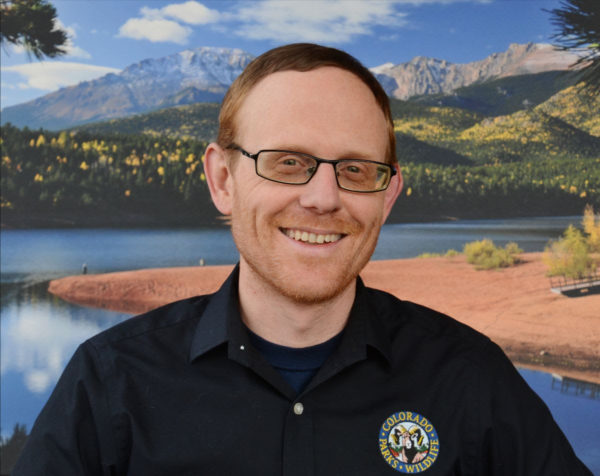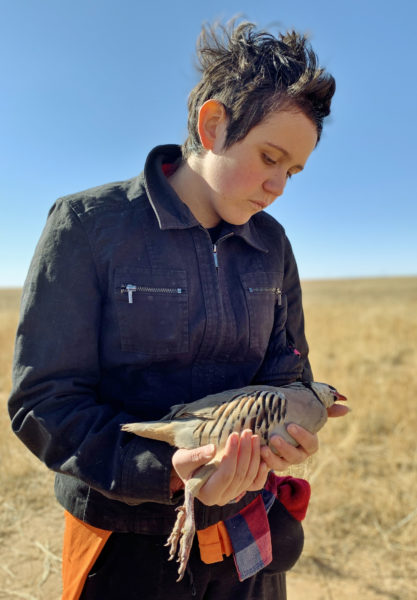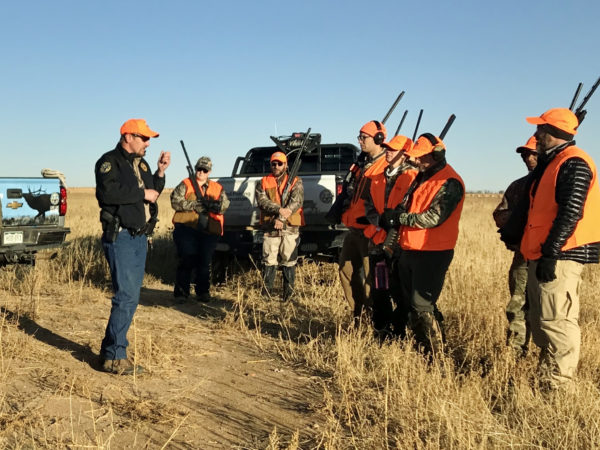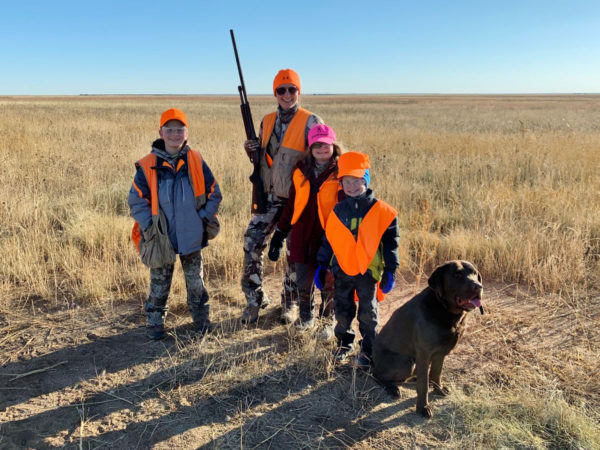Meeting new friends a bonus of hunting as we harvest our first game bird in the most unusual way possible
By Travis Duncan
Colorado Parks and Wildlife

One of the things my daughter, Natalie, and I have enjoyed learning to hunt is the friends we’ve made during the process.
For the past 10 months, we have attended Colorado Parks and Wildlife’s Rookie Sportsperson Program (RSP) offered by CPW’s Southeast Region headquartered in Colorado Springs. The RSP takes people like Natalie and me, who have little or no outdoor experience, and teach them outdoor skills. Hopefully, attendees are inspired to get outside and sample all the adventures available in Colorado’s great outdoors.

Photos courtesy of Colorado Parks and Wildlife.
We are learning about hunting, fishing, camping, hiking and much more. We became certified in the safe handling of firearms through a Hunter Education course and have been out on a couple of small-game hunts with our mentor, District Wildlife Manager (DWM) Logan Wilkins.
Along the way, we’ve met a lot of other CPW wildlife officers who work with Wilkins. And we’ve befriended other RSP classmates.

And then there are the new friends we made on the hunts. Most recently, we met Quigly, Dozer, Sage, and Bill.
They are the hunting dogs who accompanied us on our first pheasant hunt. Quigly is Wilkins’ German short-haired pointer. Dozer and Sage are Labrador retrievers and belong to DWM Sarah Watson. Bill is DWM Aaron Berscheid’s chocolate Lab.
Natalie and I have enjoyed getting to know the DWM’s dogs and we have a new appreciation for all they add to the hunting experience. Not only do they provide companionship and unconditional friendship as we tramp through fields trying to scare up game birds, but they work hard to flush birds and retrieve downed birds for those hunters lucky enough to shoot one.

Dogs are so respected by hunters that injuring a dog from an errant shot carries a fine of $10,000 at the bird farm we visited. All the more reason to adhere to the cardinal rule of hunting: Know exactly what you are targeting with your shots.
Unfortunately for me, for the second straight hunting outing, I was unable to provide any work for the dogs. Last time I failed to bring home any doves. While pheasant, Bobwhite quail, and chukar aren’t as fast as doves (like trying to shoot electrons out of the sky), they still eluded my shotgun blasts.
But we didn’t come home empty-handed thanks to a quirk of hunting at bird farms. Here’s the story.
Natalie and I prepared with our RSP classmates by attending the RSP Upland Game 101 class taught by Pikes Peak Pheasants Forever’s local chapter president John Finnessy and DWM Berscheid.
The class mainly focused on pheasants, since that’s what we would be hunting the following morning. We learned about the requirements for good pheasant habitat. Pheasants require good nesting cover, like dense grassland, that provides the birds with a food source and protection from predators. The brood-rearing cover requires areas where you can see the dirt through the plants.

“That’s where the bugs and insects are going to be,” Finnessy said. “And in winter, pheasants need denser cover to provide protection from snow.”
Finnessy told us hunters should think about pheasant behavior when preparing for a successful pheasant hunt. In the morning, the birds will be in thick cover (roosting habitat).
As the day went by, he said they would move into fields to feed. Around mid-day, they’d move back into what he referred to as “loafing cover” – fence rows or the grassy edges of fields where they can hide “and relax a little easier.” By late afternoon, they would move back to denser roosting cover for the evening.
Berscheid delivered an important reminder to our class about legal and safety issues regarding pheasant hunting.“Know who you’re hunting with,” Berscheid said.
“Make sure they have the same values that you do and you trust them to make safe shots. “Tomorrow, we will have dogs hunting with us. When you’ve got dogs involved, take shots where there is sky (visible) below the bird. No (ground) level or below-level shots. Know where your hunting partners are at all times. Wearing orange is a really good idea. No bird is worth a shot you can’t take back.”
The next morning, Natalie and I woke up before the sun and headed east of Colorado Springs to the town of Rush, where we met up with the other RSP participants at Steel Fork Pheasants for our hunt.Steel Fork Pheasants is a private company offering all-day upland bird hunting experiences.
The birds offered at Steel Fork are pheasant, (Ringneck, Manchurian and Black), Bobwhite Quail, and chukar – all on more than 10,000 acres.Our dog friends joined us as we headed out to the fields for our hunt, most of us wearing pheasant vests, orange hats and carrying our shotguns, muzzles pointed safely skyward.
As we waited to be paired up with our DWMs, Natalie sat on the ground, petting and getting to know Quigly and Bill.Eventually, Natalie and I were paired up with Berscheid and his dog, Bill. We also had another RSP couple with us and their two children.
We made a plan to cross the field, leaving a distance of 15 yards or so between us, and we kept pace with Bill. Berscheid give his dog constant encouragement to: “Hunt ‘em up, Bill! Find that bird!”
This is when our quirky harvest occurred. Halfway across the field, I heard Natalie say “chukar!” I looked at her, puzzled.“What?” I asked.“Chukar,” she said, pointing to the ground in front of her.I peered closer and, sure enough, there was a chukar partridge on the ground sitting quietly.
Berscheid came over and told us to be ready. He was going to attempt to “flush” the bird – or get it to fly up into the air. I readied myself, taking the safety off of my shotgun.
But when he touched the bird with his boot, it remained sitting calmly on the ground. Berscheid picked it up and examined it, even giving it a few tosses up and down like a football to see if it would fly.
But it didn’t fly. Instead, the bird died while being handled. Natalie was awarded the harvest. She had her first upland game bird without firing a shot! Berscheid said when game farms place birds in a field, the transition can sometimes disorient them. He speculated this chukar just didn’t survive the transition.
A few of the other RSP participants managed to harvest game birds the traditional way with their shotguns as we made several passes across the field. I took three shots total, but didn’t manage to hit anything. The RSP group as a whole harvested five birds: two chukars, two pheasant hens, and one pheasant rooster.
We took our birds back to the Steel Fork Pheasants clubhouse where we were shown how to dress the birds. They reminded us that if this was a wild hunting situation, we would need to leave evidence of sex attached until we got our harvest home. When hunting wild pheasants, it is illegal to shoot a hen.
Natalie and I cleaned our chukar, removing the head and feathers. Berscheid showed us a trick for removing most of the tendons from the bird’s leg – you break it just above the spur, then step on it and yank up, pulling the tendons out and making for less chewy eating.
We sealed our chukar in a plastic bag, put it in the cooler in the back of the truck and drove home.Back at the house, I cut off the breast meat and seasoned it with some olive oil and salt. I did the same with the drumsticks and placed it in some foil on our outdoor grill. As I am a simple man, I cooked it as I would chicken.
When it was done, we enjoyed our harvest. We didn’t get lucky enough to harvest a turkey earlier in the year, so this was the first time I had taken a game bird through the whole process from field to table.
I must say I was thankful for the experience.I have a late season pronghorn tag for December, so I’ll be spending the coming month scouting and preparing for my hunt. You’ll be able to read all about it in the next installment of Field Notes of a Rookie Sportsperson.
Travis Duncan is a public information officer for Colorado Parks and Wildlife in Denver. Travis has lived in Colorado nearly 20 years and loves the outdoors. If you have a question, please email him at [email protected]
Support Northern Colorado Journalism
Show your support for North Forty News by helping us produce more content. It's a kind and simple gesture that will help us continue to bring more content to you.
BONUS - Donors get a link in their receipt to sign up for our once-per-week instant text messaging alert. Get your e-copy of North Forty News the moment it is released!
Click to Donate
